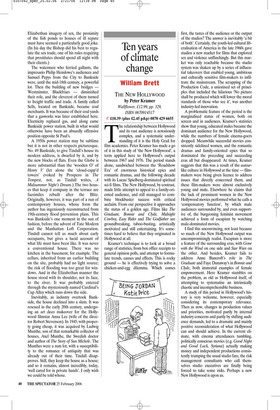Ups and downs of Bankside
Clive Aslet
THE HOUSE BY THE THAMES AND THE PEOPLE WHO LIVED THERE by Gillian Tindall Chatto, £20, pp. 258, ISBN 0701175931 ✆ £16 (plus £2.45 p&p) 0870 429 6655 Walk over Lord Foster’s wobbly bridge from St Paul’s and you will see, squashed between Tate Modern and the reconstructed Globe Theatre, a threestorey house that, according to an inscription, is where Sir Christopher Wren stayed while building the cathedral. Alas, the legend, acceptable in the 1940s when the words were put up, no longer holds water. The house was not built until 1710, long after Wren had a use for it. But the story that Gillian Tindall weaves in this book is no less fascinating for an absence of grand characters — in many ways it is the better for it. The house becomes a window through which the reader can view eight centuries of the busy, everyday riverside life which shaped this now voguish quarter of London. Nowhere in the capital has undergone such vicissitudes, and yet — thanks to Tindall’s immaculate research — we can now see the shadows of the past lingering on every paving stone and signpost.
There is an interesting etymological excursus on brothels. Ages ago I went to an exhibition about bath-houses which claimed that the Shakespearian ‘stews’ derived their name from the licentiousness associated with Turkish baths. Bankside, being outside the City walls, was a great place for them, along with other dubious activities, such as theatre-going. Tindall convincingly argues that the stews were originally the Bishop of Winchester’s fishponds. The Bishop’s palace lay around what is now Clink Street (the ‘clink’ was his prison). Fish were in great demand, given the number of fast days in the religious calendar, and like other great men he kept a ‘pike garden’ to provide a ready supply. The area around the ponds seems generally to have acquired the name of stews or ‘stewside’. And so when a 15th Duke of Norfolk is recorded as having been lent some money while ‘he lay at the stews’, it is not to be thought that he was at a bordello; if he had been, the clerk is unlikely to have drawn attention to it in the accounts. Since slippery, stinky fish were part of the Elizabethan imagery of sex, the proximity of the fish ponds to houses of ill repute must have seemed a particularly good joke. (In his day the Bishop did his best to regulate the sex trade, one of his rules requiring that prostitutes should spend all night with their clients.) The watermen who ferried gallants, the impresario Philip Henslowe’s audiences and Samuel Pepys from the City to Bankside were, until the mid-18th century, a powerful lot. Then the building of new bridges Westminster, Blackfriars — diminished their role, and the cleverest of them turned to freight traffic and trade. A family called Sells, located on Bankside, became coal merchants. It was because of their coal yards that a gasworks was later established here. Electricity replaced gas, and along came Bankside power station, built in what would otherwise have been an absurdly offensive position opposite St Paul’s.
A 1950s power station may be sublime but it is not in other respects picturesque. No. 49 Bankside, to give Tindall’s house its modern address, is dwarfed by it, and by the new blocks of flats. Even the Globe is more substantial than the ‘wooden O’ of Henry V (let alone the ‘cloud-capp’d towers’ evoked by Prospero in The Tempest, not, as Tindall writes, A Midsummer Night’s Dream.) The two houses that keep it company in the terrace are facsimiles rebuilt after the Blitz. Originally, however, it was part of a run of contemporary houses, whose form the author has ingeniously reconstructed from 19th-century flood prevention plans. This was Bankside’s one moment in the sun of fashion, before the advent of Tate Modern and the Manhattan Loft Corporation. Tindall cannot tell us much about early occupants, but gives a lucid account of what life must have been like. It was never a conventional house. There was no kitchen in the basement, for example. The cellars, inherited from an earlier building on the site, probably had no light source; the risk of flooding was too great for windows. And in the Elizabethan manner the house stood with its shoulder, not its face, to the river. It was probably entered through the mysteriously named Cardinal’s Cap Alley which runs down the side.
Inevitably, as industry overtook Bankside, the house declined into a slum. It was rescued in the early 20th century, undergoing an art deco makeover for the Hollywood filmstar Anna Lee (wife of the director Robert Stevenson). In 1945, with property going cheap, it was acquired by Ludwig Munthe, son of that remarkable collector of houses, Axel Munthe, the Swedish doctor and author of The Story of San Michele. The Munthes were a rum lot, with a susceptibility to the romance of antiquity that was already out of their time. Tindall disapproves. Still, they keep the house as a house; and so it remains, almost incredibly, today, ‘well cared for in private hands’. I only wish we could be told whose.



































































 Previous page
Previous page